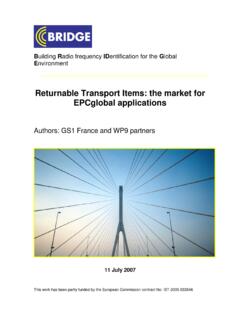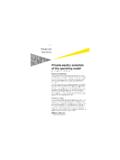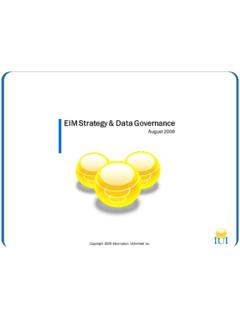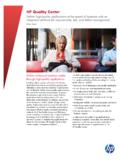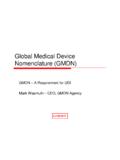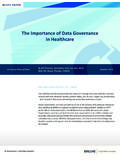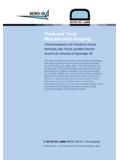Transcription of Reusable Asset Management Model - Bridge
1 Building Radio frequency IDentification for the Global Environment Reusable Asset Management Model Authors: Paul Bowman, Jason Ng (BT), Mark Harrison (Cambridge), Alexander Illic (ETH) June 2009 This work has been partly funded by the European Commission contract No: IST-2005-033546 About the Bridge Project: Bridge (Building Radio frequency IDentification for the Global Environment) is a 13 million Euro RFID project running over 3 years and partly funded ( 7,5 million) by the European Union. The objective of the Bridge project is to research, develop and implement tools to enable the deployment of EPCglobal applications in Europe. Thirty interdisciplinary partners from 12 countries (Europe and Asia) are working together on : Hardware development, Serial Look-up Service, Serial-Level Supply Chain Control, Security; Anti-counterfeiting, Drug Pedigree, Supply Chain Management , Manufacturing Process, Reusable Asset Management , Products in Service, Item Level Tagging for non-food items as well as Dissemination tools, Education material and Policy recommendations.
2 For more information on the Bridge project: This document results from work being done in the framework of the Bridge project. It does not represent an official deliverable formally approved by the European Commission. This document: This deliverable provides a contextual Model for Management of Reusable assets. Its purpose is to explain how the Track & Trace Analytics framework developed in can be applied to the Management and monitoring of Reusable assets (and specifically, different categories of Reusable transport items (RTI)) as they are used within the distribution processes of supply chains. Disclaimer: Copyright 2009 by (Cambridge, BT and ETH) All rights reserved. The information in this document is proprietary to these Bridge consortium members This document contains preliminary information and is not subject to any license agreement or any other agreement as between with respect to the above referenced consortium members.
3 This document contains only intended strategies, developments, and/or functionalities and is not intended to be binding on any of the above referenced consortium members (either jointly or severally) with respect to any particular course of business, product strategy, and/or development of the above referenced consortium members. To the maximum extent allowed under applicable law, the above referenced consortium members assume no responsibility for errors or omissions in this document. The above referenced consortium members do not warrant the accuracy or completeness of the information, text, graphics, links, or other items contained within this material. This document is provided without a warranty of any kind, either express or implied, including but not limited to the implied warranties of merchantability, satisfactory quality, fitness for a particular purpose, or non-infringement. No licence to any underlying IPR is granted or to be implied from any use or reliance on the information contained within or accessed through this document.
4 The above referenced consortium members shall have no liability for damages of any kind including without limitation direct, special, indirect, or consequential damages that may result from the use of these materials. This limitation shall not apply in cases of intentional or gross negligence. Because some jurisdictions do not allow the exclusion or limitation of liability for consequential or incidental damages, the above limitation may not apply to you. The statutory liability for personal injury and defective products is not affected. The above referenced consortium members have no control over the information that you may access through the use of hot links contained in these materials and does not endorse your use of third-party Web pages nor provide any warranty whatsoever relating to third-party Web Building Radio frequency IDentification solutions for the Global Environment WP3: Reusable Asset Management , 3/53 Bridge Building Radio frequency IDentification solutions for the Global Environment WP3: Reusable Asset Management , 4/53 TABLE OF CONTENTS EXECUTIVE SUMMARY.
5 6 GLOSSARY .. 7 1 INTRODUCTION .. 8 AIMS .. 8 RATIONALE .. 9 SCOPE .. 9 METHODOLOGY .. 11 2 RTI MODELS .. 12 TYPICAL RTI MODELS .. 12 Exchange Model (Closed-loop circulation) .. 13 Pooling Model (Open-loop circulation) .. 14 Key observations .. 14 Manufacturer .. 15 Retailer .. 15 Distribution centre .. 15 Maintenance centre .. 15 Supplier of new RTIs .. 16 Third party logistics .. 16 Pooling operator .. 16 Reusable ASSETS IDENTIFICATION .. 16 Identifiers used with Reusable assets .. 16 Associations between the identifiers .. 19 3 RTI USE CASES .. 21 OVERVIEW .. 21 WOODEN PALLET Management .. 21 PLASTIC PALLET Management .. 23 KEG Management .. 24 FOLDING PLASTIC SECURITY CONTAINER Management .. 26 SUMMARY .. 27 4 RTI ANALYTICAL MODELS .. 30 AIMS .. 30 BACKGROUND .. 31 RTI Management 31 Qualitative analysis and assessments .. 32 Delivery of empty RTIs .. 34 Use of (loaded) RTIs .. 34 Collection of empty RTIs.
6 35 Maintenance of RTIs .. 36 RTI information Management .. 37 Bridge Building Radio frequency IDentification solutions for the Global Environment WP3: Reusable Asset Management , 5/53 Quantitative analysis and assessments .. 40 Cost benefit analysis .. 40 Investment cost assessment .. 43 Pool operator perspective .. 43 FMCG manufacturer and retailer perspective .. 44 SUMMARY .. 45 5 END USER TRACK AND TRACE QUERIES .. 46 AIMS .. 46 END-USER QUERIES .. 46 6 REFERENCES .. 49 Bridge Building Radio frequency IDentification solutions for the Global Environment WP3: Reusable Asset Management , 6/53 Executive Summary This deliverable provides a contextual Model for Management of Reusable assets. Its purpose is to explain how the Track & Trace Analytics framework developed in can be applied to the Management and monitoring of Reusable assets (and specifically, different categories of Reusable transport items (RTI)) as they are used within the distribution processes of supply chains.
7 We begin by examining different categories of Reusable transport items and also distinct operational models for the flows of Reusable transport items. In particular, we study closed-loop flow (the exchange Model ) and open-loop flow (the pooling Model ) and examine the roles of the different actors who are involved with the returnable transport items. These include the manufacturer, retailer, distribution centre, maintenance organisation, supplier of new returnable transport items, third party logistics providers and the pooling operators. We discuss how GS1 EPC standard identifiers such as the Global Returnable Asset Identifier (GRAI) can be applied to returnable transport items and the possible associations that can be made between the identity of the goods transported and the identity of the container. We provide an overview of a number of use cases, involving wooden pallets, plastic pallets, Management of brewery kegs, as well as folding plastic security containers, identifying the key performance indicators and the metrics that are used for the Management of the returnable transport items.
8 We also discuss analytical models, examining what information is required by each actor, whether they are the hirer of the Asset , the end user of the Asset or the pool provider of the Reusable Asset . We also consider the needs for maintenance of the assets and the information Management that is required to balance supply and demand of assets. We have provided a comparison of RTI Management processes, looking at the impact of adding RFID to each process step. We also provide a quantitative cost benefit analysis of the impact of RFID on the existing cost structure, considering various parameters and the perspectives of the pool operator, manufacturer and retailer of fast moving consumer goods products. From this analysis, we identify a number of high-level track & trace queries that could be useful for monitoring and managing the flow of the Reusable assets. Some of these are described in further detail in Bridge Building Radio frequency IDentification solutions for the Global Environment WP3.
9 Reusable Asset Management , 7/53 Glossary 3PL Third-Party Logistics Provider DC Distribution Centre DS Discovery Service EDI Electronic Data Interchange EPC Electronic Product Code EPCIS Electronic Product Code Information Service FDIS Final Draft International Standard FMCG Fast Moving Consumer Goods FPSC Folding Plastic Security Container GDTI Global Document Type Identifier GIAI Global Individual Asset Identifier GLN Global Location Number GRAI Global Reusable Asset Identifier GSRN Global Service Relation Number GTIN Global Trade Item Number IBC Intermediate Bulk Container ISO International Organization for Standardization KPI Key Performance Indicator RFID Radio Frequency IDentification RPC Returnable Product Container RTI Returnable Transport Item SGTIN Serialized Global Trade Item Number SKU Stock Keeping Unit SRU Shelf Ready Unit SSCC Serial Shipping Container Code SSLT Site sub location type SSLTA Site Sub-Location. Type Attributes UII Unique Item Identifier URI Uniform Resource Identifier URL Uniform Resource Locator WIP Work In Progress XML eXtensible Markup Language Bridge Building Radio frequency IDentification solutions for the Global Environment WP3: Reusable Asset Management , 8/53 1 Introduction Whenever raw materials are transported to production sites so that goods and items can be manufactured and distributed through onward supply chains to the end user, there is inevitably a need for containers for transport between the various stages.
10 The associated packaging or containers might be disposable or, increasingly, they can be returnable for reuse. Although RTIs (Returnable Transport Items) can coexist with specific goods and be tracked in a similar manner to the goods for a period of time, they are inevitably separated and associated with different goods. This task will thus describe the contextual models for Reusable Asset Management that are based on current typical practices in the RTI (Returnable Transport Item) industry. Reusable containers, pallets, roll-cages, etc are tagged with RFID tags and tracked in order to improve operational efficiency throughout their lifetime in the supply chain. Issues such as dwell time, cycle-time, loss & damage, etc. will also be addressed in this study. Consideration will also be given to the different stakeholders that are generally involved in the handling and Management of RTIs. Relationships between these Reusable entities and the products (both loaded and unloaded) will be examined from these different stakeholders domain of interest and perspective.






